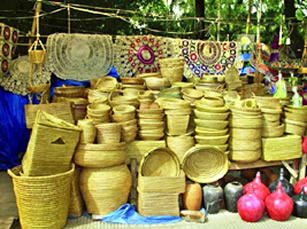Handicrafts
Handicrafts products from cottage based small manufacturing units. Some handicraft products often have identifying features such as traditional or artistic deriving from the region of production by craftsmen, working generally on a cottage industry basis. The customer-oriented definition of handicrafts suggests that it is the creative expression of a group of people with unique artistic skills who apply their talents to the production of material goods, which reflect their culture and heritage.

The most important industries in Bangladesh in early and medieval times comprised handicrafts and cottage industries. Prominent amongst them were textiles, metal works, jewelry, wood works, cane and bamboo works, and clay and pottery. Later, jute and leather became the major raw materials for handicrafts. The result is a fascinating variety of baskets, pottery, wall hangings, handbags, travel kits, toys, ashtrays, carpets, embroidered quilts, and so on.
These products are characterised by utility, sustainability and environment friendliness blended with aesthetics appeal and are suitable for everyday use. The most predominant features of Bangladeshi handicrafts are the extensive use of individual skill and the interesting design motifs.
Early records show that Gangetic muslin reached even Roman and Greek empires. Chinese and Arab travelers also took note of the fine cotton and silk produced in Bengal. Since the 16th century, fine hand-woven textile as well as superior ivory, silver and metal objects from the Suba of Bengal were prized possessions at the court of the Mughals.
Mughal kings patronised the arts and crafts and commissioned the whole community of artists for making items of decoration for their use and for giving away as gifts.
During the early Mughal period, craftsmanship got patronage of the nobility, who sent presents to the imperial courts in Delhi. Local consumption by rulers and the elite also promoted development of handicrafts. artisans played the most important part in the production of handicrafts and the fact that they worked chiefly for people, had added a unique personal touch to their work.

Besides contributing to foreign exchange earnings, generating employment, and creating the opportunities to utilise indigenous resources, handicraft plays a vital role in sustaining the rural economy and cultural heritage of the country. Handicrafts created by the works of painters and sculptors, as well as craft workers who have little or no training as artists and create their work for other people rather than museums or wealthy collectors, embody the cultural heritage of the country. Most handicrafts cater to the needs of the common people, although they originate through the patronage of the rich. Over time, they acquire the dignity of a craft. The members of the craftsmen family or cooperatives are employed in the handicraft production unit at the cottage level. The workers (skilled or semiskilled) are paid their wages on a daily basis. The handicraft sector is an important employment provider, especially in the rural areas. In the 1990s, according to a study covering seven countries in Asia, 4 million people worked full-time on craft production, while another 4 million worked part-time.
In export trade of the country, handicrafts are considered non-traditional items with a huge potential for expansion. Being a developing country, Bangladesh faces tough competition in export of finished goods in the manufacturing sector, but' many developed countries, however, give preferential treatment to the import of handicraft from Bangladesh. [Zakir Hossain Bhuiyan]
